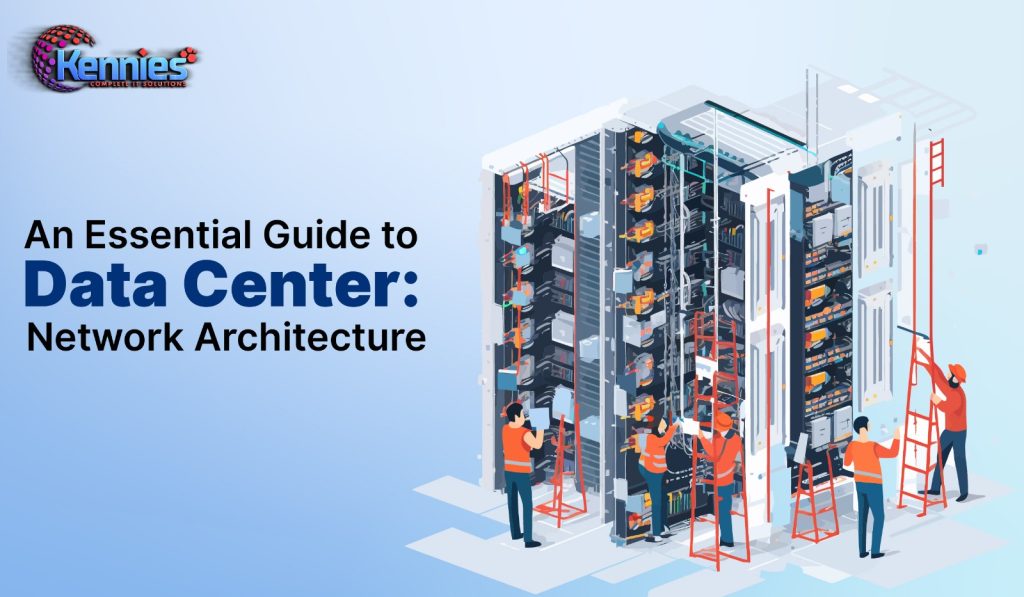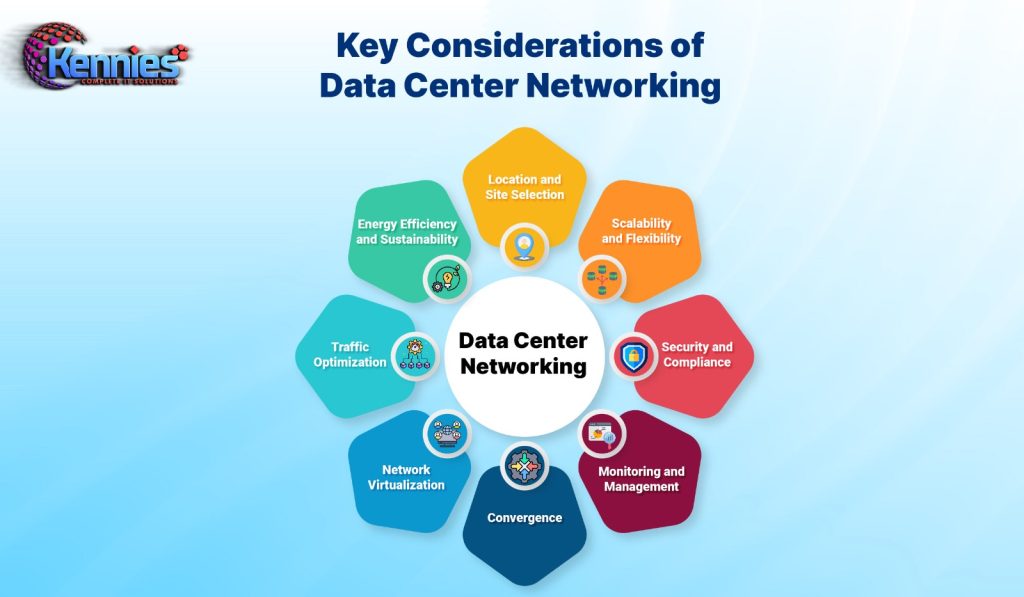
Data Centers play a vital role in securing your business’s important data. Data Centers are the backbone of the digital era and help in pioneering tomorrow’s interconnected world. Data Centers have now revolutionized data storage effectively while supporting cloud storage, server management, and network security. These data centers are pivotal in driving the virtualization technologies that shape our digital experiences. As we delve into the world of data centers, it is necessary to understand their importance and everything about them. This guide provides a comprehensive look at data centers including it’s their major components and innovations shaping their future.
Data Center integrates multiple networking resources like switches, cables, routers, load balancers, firewalls, storage systems, virtual private networks (VPNs), and intrusion prevention systems (IPS). These hardware and software components work together to enhance connectivity, storage, processing, monitoring and management, and security for multiple applications and data. Without these necessary components, devices within a data center would be unable to communicate with one another or connect to external networks.
Understanding Data Center Network Architecture Topology
A Data Center is a hub for centralizing the processing, storage, transmission, exchange, and management of necessary information. During a data center’s planning and construction phases, one of the most important aspects is the design of its architecture. The architectural blueprint configures between switches and servers within the data center.
A data center network architecture is the blueprint that defines how data moves within and outside a data center. It oversees the placement of key elements like servers, storage networking, racks, and other necessary resources while detailing how these devices would get interconnected to ensure optimal functionality.
Data Center (DC) Network Architecture topology is the structural layout of organizations’ network components in a data center. Its primary objective is to assure quick, reliable, and secure data exchange among servers, storage devices, and external networks. The key elements of this architectural framework are:-
Data Center Racks and Cabinets
- Data Centers acquire multiple servers and networking equipment, specifically organized into racks and cabinets.
- These structures boost space utilization and offer a structured environment for components.
Data Center Switches and Routers
- Switches & Routers are the basic network devices that allow devices to interlink with each other and other networks.
- They are used for connecting servers & configuring networks. Switches interlink multiple devices on the same network in data center.
Data Center Cabling
- Cabling interlinks servers, switches, and routers together through wires.
- It includes copper cables, fiber optic cables, and Ethernet cables, each of which serves a specific purpose based on distance and speed needs.
Top-of-Rack (ToR) Switches
- ToR switches connect several servers within a single rack and are located at the top of server racks.
- It makes network administration simpler and reduces cable clutter.
Load Balancers
- Load balancers distribute network traffic among several servers to prevent overload and ensure peak performance.
Firewalls and Security Appliances
- Security is one of the major aspects of a Data Center. Firewalls and security appliances safeguard against cyber threats.
Virtualization
- Virtualization Technologies are a catalyst for creating virtual networks, servers, and storage resources.
- These are necessary for resource optimization and flexibility in a data center.
Importance of Data Center Networking
The importance of Data Center Networking is multi-factorial, wherein it dynamically connects, protects, and adapts organizational environments. Data Center Networks assure businesses with paramount services for applications and data, including high availability and reliability, scalability and flexibility, enhanced data security, efficient resource utilization, network traffic optimization, and virtualization and cloud services.
Key Considerations of Data Center Networking

Designing a data center network architecture includes necessary considerations. While considering these important factors, architects can construct a robust and effective network infrastructure that ful-fills the requirements of today’s and future data center needs.
Location and Site Selection: Choose the right geographic location for a data center. In this manner, businesses ensure proximity to users, minimizing disaster risks.
Scalability and Flexibility: Data centers must accelerate demand and technology growth, necessitating infrastructure that grows flawlessly and adapts to changing needs without causing substantial interruptions.
Energy Efficiency and Sustainability: Prioritize energy-efficient techniques and renewable energy sources to reduce operational costs and environmental effects while remaining consistent with sustainability goals.
Traffic Optimization: Optimizing network traffic ensures that data is transmitted efficiently, which improves the website’s performance and user experience.
Security and Compliance: To protect sensitive data and prevent cyber threats, implement strong security measures, and follow regulatory compliance standards.
Convergence: Integrate diverse networking technologies and services to streamline operations and minimize complexity, enhancing overall efficiency and agility.
Network Virtualization: Use technologies to optimize network resources, simplify dynamic allocation and management, and improve scalability and resource utilization.
Monitoring and Management: Comprehensive monitoring and management tools provide real-time insights into network performance, allowing for preemptive maintenance and troubleshooting.
Future-Proofing: Invest in technologies and infrastructure that opt for future advancements assuring longevity and minimizing the need for costly upgrades or migrations.
Highlighting how data centers lead the way in future Infrastructure
| Aspect | Description |
| Technological Innovations | Assisting highly advanced technologies like AI, IoT, and edge computing for boosted data processing |
| Energy Efficiency Initiatives | Opting for renewable energy sources, efficient cooling systems, and green infrastructure for sustainability |
| Scalability and Flexibility | Efficiency to rapidly scale resources and offer flexible solutions customized to multiple client needs |
| Connectivity and Network Redundancy | Robust connectivity with multiple network carriers, ensuring high-speed and redundant network connections |
| Security Measures | Advanced security protocols, encryption, and compliance certifications for data protection and privacy |
| Disaster Recovery and Resilience | Redundant systems, backup solutions, and disaster recovery plans assure high availability and resilience |
| Collaborations and Partnerships | Collaborations with tech giants, local enterprises, and academia for research, development, and innovation |
| Sustainability Initiatives | Efforts toward carbon neutrality, eco-friendly practices, and reduces the green initiatives |

A data center provides computing power to run programs, storage to process data, and networking to connect people to resources they need to execute their jobs and support organizational operations. Data Centers are necessary for business operations, assisting data storage, management, and distribution infrastructure. They support business continuity, scalability, and security.
Talking about the Current Trends in data Center, Data Centers involve opting for cloud computing, energy sustainability, green energy solutions, and integrating AI for enhanced facility management. Furthermore, AI would be hogging the data center spotlight, however, demand through cloud service providers would be enforced in 2024. Cloud adoption has risen more than expected in recent years while driving huge deals with data centers.
Conclusion
Data Centers are the main infrastructures for supporting multiple applications like cloud service, super computing, and social networks. In today’s data-driven business landscape, data centers assure businesses to manage, store, and analyze their data efficiently and securely. They assure you of multiple benefits like centralized data management, scalability, security, redundancy, and cost-effectiveness. Data Centers will continue to play an important role in the digital transformation of businesses.
